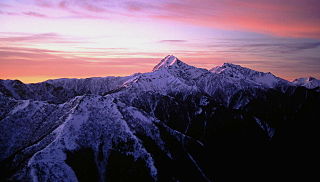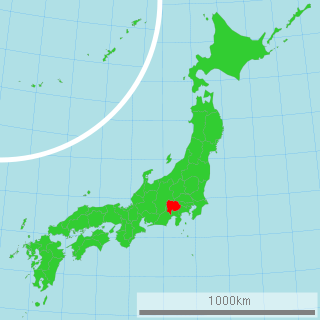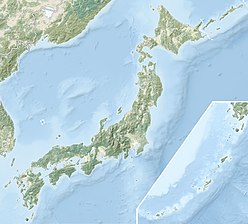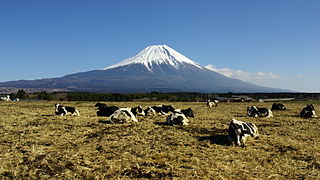
The Japanese Alps is a series of mountain ranges in Japan which bisect the main island of Honshū (本州). The name was coined by English archaeologist William Gowland, and later popularized by Reverend Walter Weston (1861–1940), an English missionary for whom a memorial plaque is located at Kamikōchi (上高地), a tourist destination known for its alpine climate. The term Japanese Alps first only included the Hida Range in the late 19th century, but now applies to the Kiso Range and Akaishi Range as well.jpg|thumb|Reverend Walter Weston called "Father of the Japanese Alps" memorial plaque at Kamikōchi in the Japanese Alps]]}}

Kiso Mountains are a mountain range in Nagano and Gifu prefectures in Japan. They are also called the Central Alps and they combine with the Hida Mountains and the Akaishi Mountains to form a group collectively known as the Japanese Alps.

Mount Kita is a mountain of the Akaishi Mountains−"Southern Alps", in Yamanashi Prefecture, Japan.

Mount Aino, or Ainodake, is a peak of the Akaishi Mountains−Southern Alps, in Minami Alps National Park, Japan.
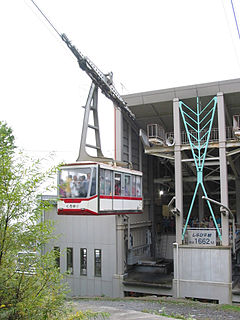
Komagatake Ropeway is an aerial lift line in the Kiso Mountains range, Nagano Prefecture, Japan.

The Hakone Komagatake Ropeway, officially the Komagatake Ropeway Line, is Japanese aerial lift line in Hakone, Kanagawa, operated by Izu Hakone Railway. The line, opened in 1963, climbs Mount Komagatake (駒ヶ岳) from the Lake Ashi lakeside.

Mount Nōtori, or Nōtoridake, is one of the major peaks in the Akaishi Mountains, along with Mount Kita and Mount Aino. The 3,026 m (9,928 ft) peak lies to the south of the other mountains, spanning the town of Hayakawa in Yamanashi Prefecture and Aoi-ku in the city of Shizuoka, Shizuoka Prefecture, Japan.

Mount Senjō is a 3,032.6-metre-high (9,949.5 ft) mountain on the border of Minami-Alps, Yamanashi, and Ina, Nagano, in Japan. This mountain is one of the major peaks of the Akaishi Mountains, and is one of the most popular peaks in the range. This mountain is also one of the 100 Famous Japanese Mountains.

Mount Nokogiri is a mountain located in the Akaishi Mountains on the border between, Yamanashi and Nagano Prefectures in Japan.
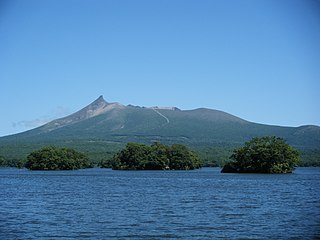
Hokkaidō Koma-ga-take, also Oshima Koma-ga-take (渡島駒ヶ岳), Oshima Fuji (渡島富士), or just Koma-ga-take (駒ヶ岳) is a 1131-meter adesitic stratovolcano on the border between Mori, Shikabe, and Nanae, all within the Oshima Subprefecture of Hokkaidō, Japan.
Komagatake may refer to one of several mountains in Japan:

Mt. Shiomi is a mountain located in the centre of the Akaishi Mountains−Southern Alps, within Minami Alps National Park, Japan. It is on the border of Shizuoka and Nagano Prefectures. It is one of the 100 Famous Japanese Mountains.

Mount Aizu-Komagatake is a mountain located in Hinoemata, Fukushima Prefecture, Japan, in the Oze National Park. It is one of the 100 Famous Japanese Mountains.
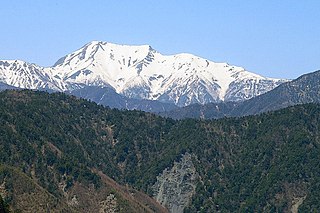
Mount Hijiri is a mountain located in the Akaishi Mountains in both Aoi-ku, Shizuoka, Shizuoka Prefecture and Iida, Nagano Prefecture, in the Chūbu region of Japan. It is 3,013 m (9,885 ft) tall and part of the Akaishi Mountains. It is the mountain in Minami Alps National Park located in the south most. It is also included on the list of "100 Famous Japanese Mountains." There are several mountain climbing trails and Mountain hut around the mountain. There is the Hijiri-Daira hut in the Mountain pass in the south.
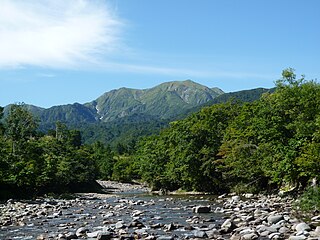
Mount Echigo-Komagatake or Uonuma-Komagatake is a mountain located on the border of Uonuma and Minamiuonuma, Niigata Prefecture, Japan, with an elevation of 2,002.7 m (6,571 ft) It is one of the 100 famous mountains in Japan. Mount Echigo-Komagatake, along with Nakanodake and Mount Hakkai, is also one of the three great mountains of Echigo, the old name for this area of Niigata Prefecture.

Mount Hōō is located in the western portion of Yamanashi Prefecture, Japan. Because the mountain has three peaks, it is also called Hōō Sanzan (鳳凰三山). It is in Minami Alps National Park and is one of the 100 Famous Japanese Mountains.

